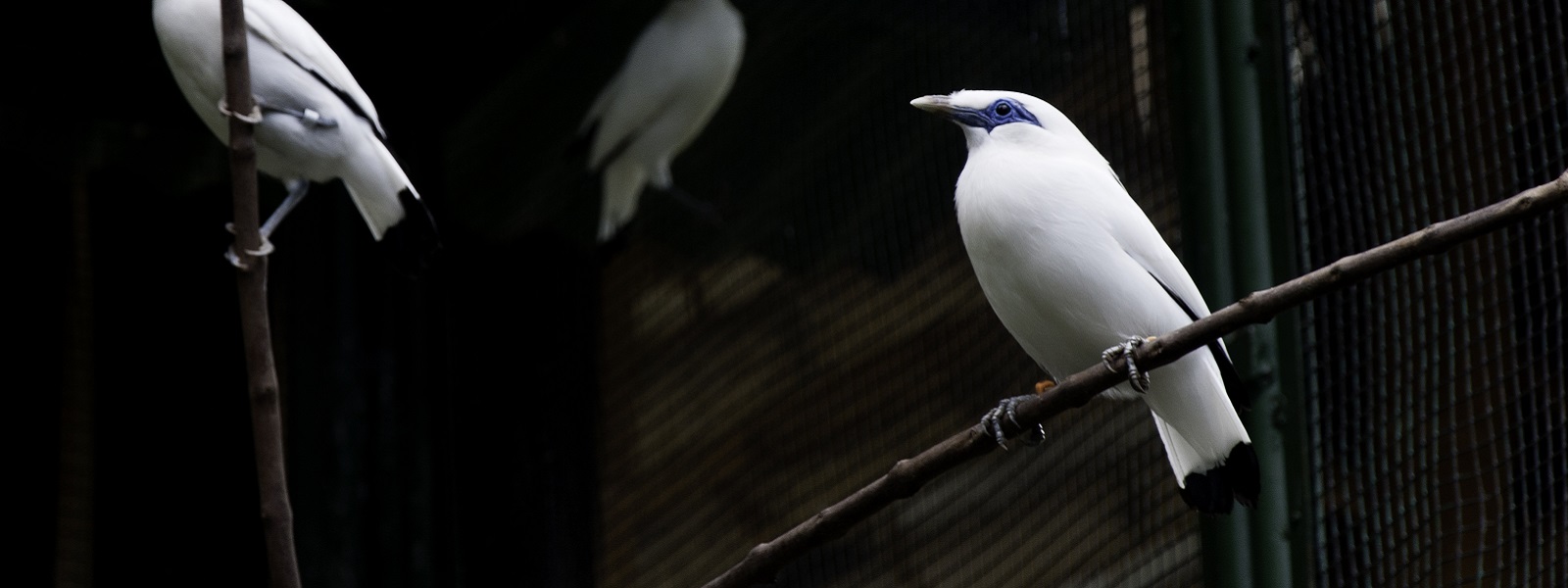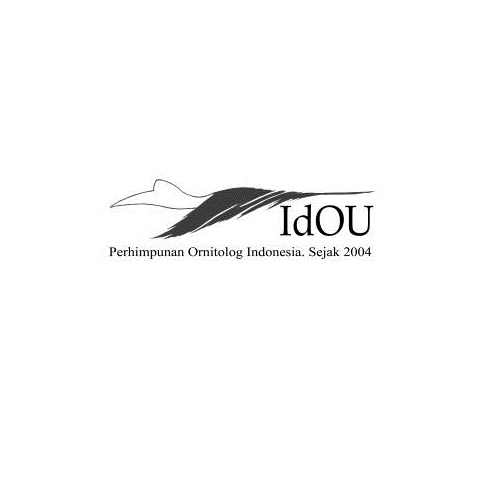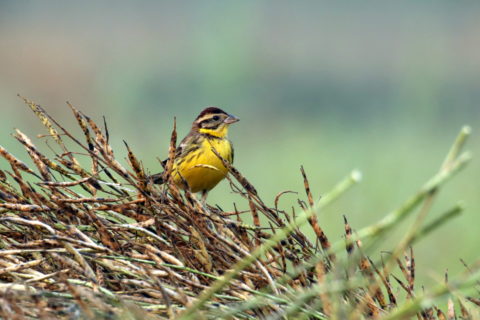Conservation Actions
Conservation and Research Actions Underway
CITES Appendix I. This species has been the focus of much conservation effort (see Jepson 2016). The species has been protected under Indonesian law since 1970 and occurs within Bali Barat National Park. Since 1983, the Bali Starling Project has helped to improve the guarding of the park, bolstered the wild population through release of captive-bred birds, and provided the foundation for the development of the Bali Starling Recovery Plan. A population derived from captive individuals was introduced to Nusa Penida Island (which is apparently not part of its native range) by Begawan Foundation. Reintroduction work has continued through the efforts of the Friends of the National Park Foundation (I. G. N. Bayu Wirayudha in litt. 2012). By the end of 2009, 65 birds had been released at Nusa Penida Island and at least 62 chicks were reported to have fledged in the wild up to 2011 (Collar et al. 2012). In 2006, a local regulation was passed to make protection of birds obligatory by all village residents on Nusa Penida, in return for support including local education and sustainable livelihoods projects (Friends of the National Parks Foundation undated). A government scheme allows locals to get captive birds on 'breeding loan' and give a small proportion of the offspring to Bali Barat National Park and sell the rest commercially (Collar et al. 2012). Since 1998, 426 individuals are thought to have been released across the national park at four locations, but these were presumed to be 'hard releases' with no subsequent monitoring of survival (Collar et al. 2012; T. Squires in litt. 2019). However, survival monitoring has recently begun in 39 released individuals, with nest monitoring ongoing (T. Squires in litt. 2019). In addition, the Wildlife Conservation Society continues to operate wildlife crime market and trade surveillance, as well as enforcement at key trading hubs in Indonesia (N. Brickle in litt. 2007). Soft releases with provision of food, water and nest boxes have recently taken place at four resorts along the north coast (Collar et al. 2012). Three more releases were scheduled for 2014 (Begawan Foundation 2014). Plans are also in place to legalise trading of the species openly across markets in order to reduce illegal trade (Craig et al. 2020).
Conservation and Research Actions Proposed
Continue to monitor population trends closely, in particular to determine whether released birds are breeding successfully. Improve genetic diversity of released populations by introducing unrelated individuals. Commence strict implementation of the Bali Starling Recovery Plan. Continue to monitor the success of the reintroduced populations at all release sites, in particular investigating interactions with native flora and fauna, as well as with local agricultural activity. Encourage community work to improve habitat conditions (I. G. N. Bayu Wirayudha in litt. 2012).
Location Information
This species is endemic to the island of Bali, Indonesia, where it formerly ranged across the north-west third of the island. It has perhaps long been uncommon. Numbers in the early 1900s, when the species was discovered, have been retrospectively guessed at 300-900 individuals, although this is thought to be a gross underestimate. Since then, it has declined drastically in population and range. Illegal poaching reduced numbers to a critically low level in 1990, when the wild population was estimated at c. 15 birds. Conservation intervention, coupled with the release of a few captive-bred birds, raised this to between 35 and 55. However, despite excellent breeding success and continuing conservation efforts, the population continues to fluctuate, falling to six birds in 2001 (P. Benstead verbally 2003). Continuing releases have raised numbers in West Bali National Park, such that surveys in March 2005 found 24 individuals (P. Wood in litt. 2005). In 2008, the population there was believed to be around 50 birds (G. Dijkman in litt. 2007, 2008). However, it is uncertain how many of these released birds have bred successfully in the wild and can be regarded as "mature individuals" following IUCN guidelines. A population derived from captive individuals has been introduced on Nusa Penida Island (which is apparently not part of the native range). This population appears to have adapted to the island and is breeding, with a total of 65 adults and 62 young present in 2009 (G. Dijkman in litt. 2007, 2008). There have been releases elsewhere (Collar et al. 2012), and the species appears to be doing well at at least one of these sites (Marsden 2017). Around 1,000 individuals are believed to survive in captivity. An apparent sighting of a pair of birds in East Java has not been confirmed; it is likely that these were escaped or released captive birds (A. Blakemore in litt. 2011).Geographic Range
Extant
Indonesia
Population Information
At the release site in West Bali National Park, c.50 individuals were estimated in 2008 (G. Dijkman in litt. 2008). At the release site on Nusa Penida Island, the population was recorded as 65 adults and 62 juveniles in 2009 (C. Kenwrick in litt. 2009). In February and March 2015, staff of Begawan Foundation and Wildlife Reserves Singapore undertook an audit on Nusa Penida and Nusa Lembongan Islands, which only found 12 adults and a possible 2 birds in nests (Halaouate 2015). At least at one other release site, the species appears to be doing well (Marsden 2017). In April 2019, 191 individuals were counted at Bali Barat National Park, following at least 100 birds being released in November 2018, although many were immature individuals (T. Squires in litt. 2019). However, as IUCN stipulates that re-introduced individuals must have produced viable offspring before they are counted as mature individuals, the population size is precautionarily assumed to be fewer than 50 mature individuals, although this may warrant revising upwards if there is continued evidence of breeding success.Threats
The species's decline to virtual extinction in the wild is primarily attributable to unsustainable, illegal trapping in response to worldwide demand for the cage-bird trade. This threat continues, despite the fact that the whole population is now confined within a national park and has been the subject of a specific conservation programme. The park and programme have, however, suffered from repeated mismanagement and corruption. In 1999, while black-market prices for the species soared (US$2,000 in mid-1990s), an armed gang stole almost all the 39 captive individuals awaiting release into the wild from the park. Trappers are therefore likely to still operate within the national park, and nests are continuing to be poached (T. Squires in litt. 2019). Prices for the species continue to remain high, where a recent survey exposed the species being sold at several markets in Jakarta and Bandung for prices between US$752-1,278 (Nijman et al. 2017). These serious problems are compounded by habitat loss, due to factors such as conversion of woodlands to plantations and human settlements (Craig et al. 2020). With the population now at such a critically low level, other threats may include genetic erosion, interspecific competition, natural predation and disease. Trapping is recently suspected to have taken place among the released population at Nusa Penida Island (M. Halaouate in litt. 2013). In February and March 2015, staff of Begawan Foundation and Wildlife Reserves Singapore undertook an audit on both Nusa Penida and Nusa Lembongan, which only found 12 adults and a possible 2 birds in nests (Halaouate 2015).Partners
IUCN Red List Account Link
Please click here to see the species' IUCN Red List Account page.Photo Credits
Begawan Foundation (category and featured image)










